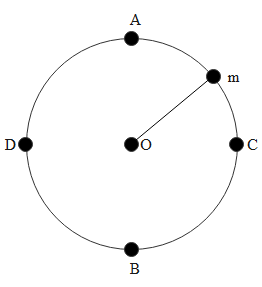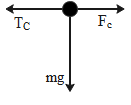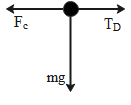
A mass is performing vertical circular motion (see figure). If the average velocity of the particle is increased, then at which point is the maximum breaking possibility of the string:


Answer
483.3k+ views
Hint: When an object attached to a string is moving in a circular motion it can rotate due to the forces acting as centripetal (tension force for the concerning question) and centrifugal forces. The forces acting at any point in the path of the motion can be studied with the help of a free body diagram (FBD). And at a point where there is maximum tension, there will be high chances of the breakage of the string.
Complete answer:
When an object is moving in a vertical circular motion as shown in the above diagram. The FBD for each point and the equilibrium equation can be given as,
The case I: (at point A)

Concerning the FBD at point A at equilibrium state we can say that the centrifugal force acting on the body is equal to the tension force at A and the force mg.
Mathematically,
Case ll: (at point C and D)


Concerning the FBD at point C and D at equilibrium state, the relation between the forces can be given as follows,
Case lll: (at point B)

Concerning the FBD at point B at equilibrium state, we can say that the tension force acting on the body is equal to the centrifugal force at B and the force mg.
Comparing the equations (1), (2), and (3) we can conclude that the tension will be maximum at point B. and when there is maximum tension there are the highest chances for the breakage of the string.
Thus the required answer to the question is point B.
Note:
Centripetal force is the force which makes the body rotate in a circular path. And from Newton’s
Complete answer:
When an object is moving in a vertical circular motion as shown in the above diagram. The FBD for each point and the equilibrium equation can be given as,
The case I: (at point A)

Concerning the FBD at point A at equilibrium state we can say that the centrifugal force acting on the body is equal to the tension force at A and the force mg.
Mathematically,
Case ll: (at point C and D)


Concerning the FBD at point C and D at equilibrium state, the relation between the forces can be given as follows,
Case lll: (at point B)

Concerning the FBD at point B at equilibrium state, we can say that the tension force acting on the body is equal to the centrifugal force at B and the force mg.
Comparing the equations (1), (2), and (3) we can conclude that the tension will be maximum at point B. and when there is maximum tension there are the highest chances for the breakage of the string.
Thus the required answer to the question is point B.
Note:
Centripetal force is the force which makes the body rotate in a circular path. And from Newton’s
Latest Vedantu courses for you
Grade 11 Science PCM | CBSE | SCHOOL | English
CBSE (2025-26)
School Full course for CBSE students
₹41,848 per year
Recently Updated Pages
Master Class 11 Economics: Engaging Questions & Answers for Success

Master Class 11 Business Studies: Engaging Questions & Answers for Success

Master Class 11 Accountancy: Engaging Questions & Answers for Success

Master Class 11 English: Engaging Questions & Answers for Success

Master Class 11 Computer Science: Engaging Questions & Answers for Success

Master Class 11 Maths: Engaging Questions & Answers for Success

Trending doubts
State and prove Bernoullis theorem class 11 physics CBSE

What are Quantum numbers Explain the quantum number class 11 chemistry CBSE

Write the differences between monocot plants and dicot class 11 biology CBSE

Why is steel more elastic than rubber class 11 physics CBSE

Explain why a There is no atmosphere on the moon b class 11 physics CBSE

1 ton equals to A 100 kg B 1000 kg C 10 kg D 10000 class 11 physics CBSE




